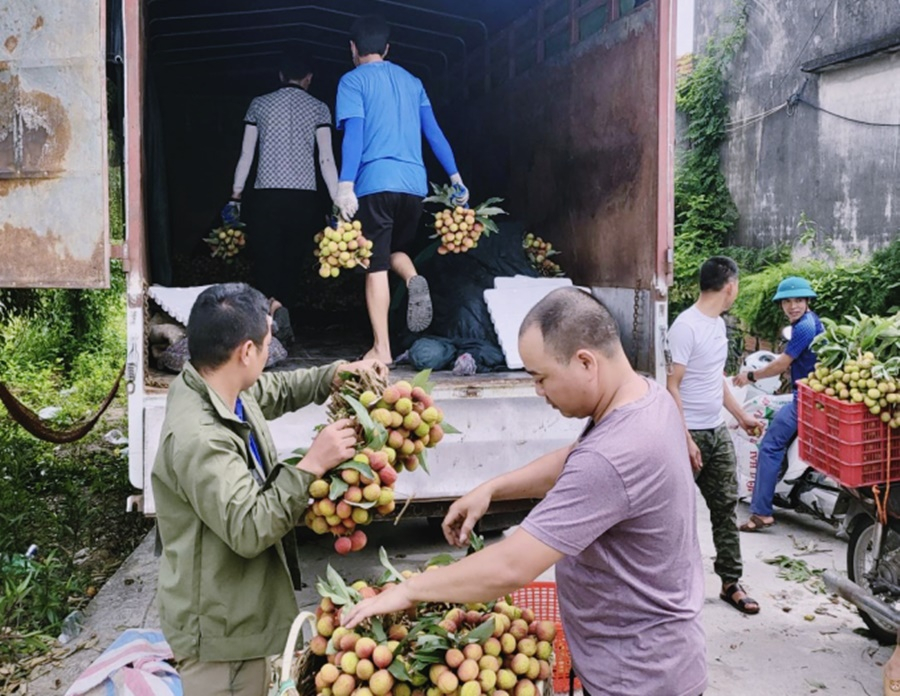PLANTING AREA CODE: A SOLUTION TO BUILD TRUST FOR AGRICULTURAL PRODUCTS
|
In agricultural production, the growing area code is understood as an identifier for a growing area, in order to monitor and control the production situation, control harmful organisms, trace the origin of agricultural products... Time Recently, Quang Ninh province has focused on encouraging localities to register planting area codes and consider this as a "passport ticket" for exporting agricultural products to the international market. People in Phuong Nam ward, Uong Bi city consume early ripe litchi. Quang Ninh currently has 14 growing areas and 5 packing facilities that have been granted codes by China to be eligible for export to this market. Including 7 litchi growing areas in Dong Trieu, Uong Bi; 4 dragon fruit growing areas in Mong Cai, Uong Bi; 5 establishments packing longan, litchi, dragon fruit, mangosteen, rambutan, mango, banana, jackfruit, watermelon, for export in Dong Trieu, Uong Bi, Quang Yen and Mong Cai. This is considered a good sign for farmers in the province, because dragon fruit and lychee are both very popular fruits in the Chinese market but have a very short harvest time (25). -35 days), the output is large, so if it is not consumed in time, it will cause the price to drop. Mr. Nguyen Trung Thanh, Director of the Sub-Department of Cultivation and Plant Protection (Department of Agriculture and Rural Development), said: In order to be granted a planting area code, agricultural products are produced according to a certain process from the required area. cultivation, cultivation conditions, record books, field hygiene, pest composition in the production area, to requirements on plant protection drugs. The development of the growing area code not only helps to trace the origin and ensure strict conditions for food safety, but also changes the awareness and actions of people, businesses and managers in the area. localities in improving productivity, area, quality and output for products. As one of the key fruit-growing regions of the province, in recent years, Phuong Nam and Uong Bi City's early-ripening litchi products have increasingly affirmed their brands and reached out to the international market. In Phuong Nam ward, there are nearly 400ha, growing early ripening litchi, with an annual output of about 2,000 tons. Uong Bi City has approved the Phuong Nam early ripening litchi production project according to VietGAP process and granted the planting area code in the area. The project is implemented on 280ha of early ripening lychee with about 1,000 participating households, with a total investment of more than 15.9 billion VND, including 4 goals: Food safety; safety for producers; environmental protection and product traceability. Up to now, 100% of households participating in the Phuong Nam early ripening litchi production project according to VietGAP process have committed to strictly observe and apply farming methods according to the process, ensuring hygiene and safety. food safety and environmental protection. |
Faced with increasingly strict requirements on quality management of agricultural products, in the coming time, the province's agricultural sector will promote extensive propaganda to organizations and individuals in the area; to accompany and stand side by side in guiding and supporting production and business establishments that need to issue planting area codes and packing establishments according to regulations. The Department of Agriculture and Rural Development has also asked the People's Committees of key fruit-producing localities to direct specialized agencies and the People's Committees of communes and wards to review and check the current status of planting area codes (litchi, longan, bar long) has been issued by the Plant Protection Department for export. In addition, it is required that businesses, proactively take measures to protect their codes, promptly notify management agencies when detecting violations related to the use of codes for coordination. handle. Every 6 months, the growing areas are given codes to send the results of quality monitoring to the Department of Agriculture and Rural Development to summarize and report to the Ministry of Agriculture and Rural Development according to regulations.
Other Posts
- FDI disbursement in Vietnam hits record high
- 10 outstanding events of Vietnam's economy in 2023
- Improve efficiency from FTA agreements
- Budget revenue exceeded plan
- Economy 2023, forecast 2024: Vietnam's economy through the perspectives of international experts
- Experts emphasize the human factor when Vietnam develops the Digital Economy
- World Bank: 2023 is a "resilient" year for Vietnam's economy
- Approve the Planning for exploration, exploitation, processing and use of minerals as construction materials
- Enhance international integration capacity
- It is forecasted that international flight passengers will increase and domestic flights will decrease



